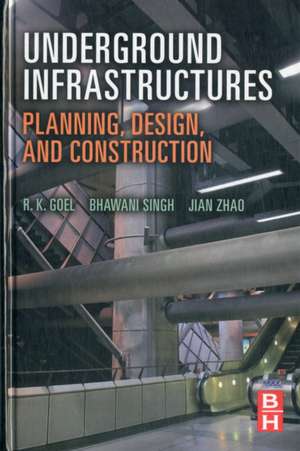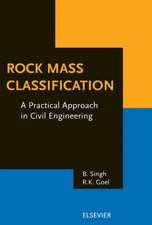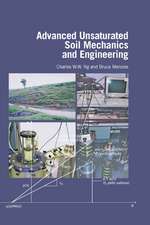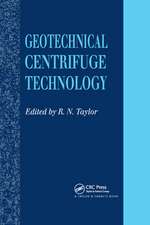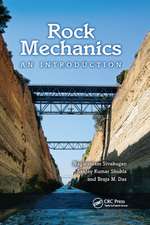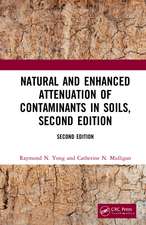Underground Infrastructures: Planning, Design, and Construction
Autor R K Goelen Limba Engleză Hardback – 19 iun 2012
One of the first book to address all of the major areas in which this technology is used, this book deals with major topics such as: hydroelectric projects with modern planning of complex underground structures; underground storages of food items, crude oil and explosives and highly cautious underground nuclear waste repositories. Rail and road tunnels and TBM are described briefly. Risk management in underground infrastructures is of vital importance. Civil Engineers, Mining Engineers, and Geotechnical Engineers will find this book a valuable guide to designing and planning underground infrastructures both in terms of its applications.
- Risk management method for underground infrastructures
- Vital tips for the underground storage of food, water, crude oil, natural gas and munitions
- Provides design tips for Underground Parking Facilities
- Instruction for the designing planning and construction for underground Metros and road tunnels
- Planning and design of underground nuclear waste repositories
- Clearly explains the benefits and drawbacks of underground facilities
- Quick guide to the various modern mechanical underground parking options
- Explanation of construction planning and Risk management
- Places expert advice for planning and constructing projects at the finger tips
Preț: 473.79 lei
Preț vechi: 570.49 lei
-17% Nou
Puncte Express: 711
Preț estimativ în valută:
90.67€ • 98.45$ • 76.16£
90.67€ • 98.45$ • 76.16£
Carte tipărită la comandă
Livrare economică 15-29 aprilie
Preluare comenzi: 021 569.72.76
Specificații
ISBN-13: 9780123971685
ISBN-10: 0123971683
Pagini: 352
Ilustrații: black & white illustrations, black & white tables, figures
Dimensiuni: 156 x 234 x 25 mm
Greutate: 0.68 kg
Editura: ELSEVIER SCIENCE
ISBN-10: 0123971683
Pagini: 352
Ilustrații: black & white illustrations, black & white tables, figures
Dimensiuni: 156 x 234 x 25 mm
Greutate: 0.68 kg
Editura: ELSEVIER SCIENCE
Public țintă
Rajnish Kumar Goel, Scientist G, Central Institute of Mining and Fuel Research (CIMFR)Bhawani Singh, Ex. Professor, Department of Civil Engineering, Indian Institute of Technology (IIT)
Jian Zhao, Chair of Rock Mechanics and Tunnelling, Swiss Federal Institute of Technology (EPFL)
Cuprins
1. INTRODUCTION
2. CLASSIFICATION OF UNDERGROUND SAPCE
3. IMPORTANT CONSIDERATIONS
4. UNDERGROUND PLANNING
5. UNDERGROUND STORAGE OF FOOD ITEMS
6. UNDERGROUND WATER STORAGE
7. UNDERGROUND CAR PARKS
8. UNDERGROUND METROS & ROAD TUNNELS
9. UNDERGROUND STORAGE OF CRUDE OIL, LPG AND NATURAL GAS
10. UNDERGROUND SPACE FOR CIVIC FACILITIES
11. UNDERGROUND STRUCTURES FOR HYDROELECTRIC PROJECTS
12. UNDERGROUND SHELTERS FOR WAR TIME
13. UNDERGROUND STORAGE OF AMMUNITIONS AND EXPLOSIVES
14. UNDERGROPUND NUCLEAR WASTE REPOSITORIES
15. CONTRACTUAL RISK SHARING
2. CLASSIFICATION OF UNDERGROUND SAPCE
3. IMPORTANT CONSIDERATIONS
4. UNDERGROUND PLANNING
5. UNDERGROUND STORAGE OF FOOD ITEMS
6. UNDERGROUND WATER STORAGE
7. UNDERGROUND CAR PARKS
8. UNDERGROUND METROS & ROAD TUNNELS
9. UNDERGROUND STORAGE OF CRUDE OIL, LPG AND NATURAL GAS
10. UNDERGROUND SPACE FOR CIVIC FACILITIES
11. UNDERGROUND STRUCTURES FOR HYDROELECTRIC PROJECTS
12. UNDERGROUND SHELTERS FOR WAR TIME
13. UNDERGROUND STORAGE OF AMMUNITIONS AND EXPLOSIVES
14. UNDERGROPUND NUCLEAR WASTE REPOSITORIES
15. CONTRACTUAL RISK SHARING
Recenzii
"Goel (Central Institute of Mining & Fuel Research, India), his long-time collaborator Bhawani Singh, and Jian Zhao (Ecole Polytechnique Federale de Lausanne, Switzerland) provide a broad guide to underground elements of cities for city planners, civil and mining engineers, architects, military engineers, administrators, and municipal authorities. Among their topics are the classification of underground space, the underground storage of water, underground metro and road tunnels, civil facilities underground, and contractual risk sharing." --Reference and Research Book News, October 2012
